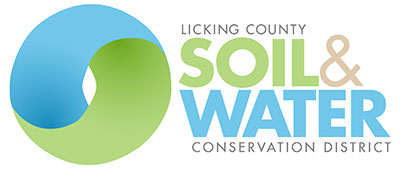Since 1944, Licking County Soil & Water Conservation District exists to promote wise use of our land and water. During those 75 years, Licking Soil & Water has worked with countless landowners to manage and protect natural resources on public and private lands. This year, for our 75th birthday, Licking Soil & Water is reflecting on our history in and impact on Licking County. Below is Part Two of a four-part series celebrating our legacy.
During the 1950s, 1960s and 1970s Licking County’s population doubled to 120,000. The Board of Supervisors hired paid employees to fully serve the community’s conservation assistance needs.
During the 1950s, the Board of Supervisors received numerous requests for technical assistance from landowners. They helped install contour strips and farm ponds, tree plantings, diversions and drainage enhancements, pasture and forest improvements, and wildlife plantings.
In 1951, Ohio House Bill 161 allowed the Licking County Commissioners to use local monies to fund Licking Soil & Water. Additionally, the bill established the local and state partnership whereby the state matched every dollar the county commissioners allocated to Licking Soil & Water. This unique partnership continues to this day.
The Supervisors established working committees and recruited community members to serve on Program, Finance, Education, Publicity, and Legislative Committees. They began nominating deserving farmers and themselves for conservation awards including the Goodyear Award for soil conservation sponsored by the Goodyear Tire and Rubber Company and the B & O Railroad soil conservation contest.
By 1966, each of Ohio’s 88 counties had their own conservation district, but they lacked a good umbrella agency to tie them together. In 1969, Ohio Senate Bill 160 nested all districts under the Ohio Department of Natural Resources and created the Division of Soil and Water Districts. Conservation education programs grew rapidly during this period and field days hosted by local farmers became social events that folks looked forward to. Topics included Farm Plans, Conservation Days, Forestry, Fishing and Ponds, and Conservation Tours by Air.
In the 1970s, technology on the farm advanced and conservation tillage changed how we planted our fields. No-till, a practice still in use today, promoted less labor, lower fuel costs, less equipment investment and lower tractor horsepower when compared to other farming practices.
Previously, most conservation practices centered on soil, but as rivers became seriously polluted and some literally caught on fire, soil and water conservation districts were a natural group to assist landowners with non-point source pollution management. The Environmental Protection Agency, established in 1970, and the Clean Water Act of 1972, opened a new education opportunity for Licking Soil & Water to begin reaching the entire community. Water quality and soil health concerns were clearly no longer limited to the farm.
Sources include:
Ohio Department of Agriculture - https://agri.ohio.gov/wps/portal/gov/oda/divisions/soil-and-water-conservation/local-swcd-resources/
Licking County Records and Archives - https://www.lcounty.com/depts/records_n_archives/



